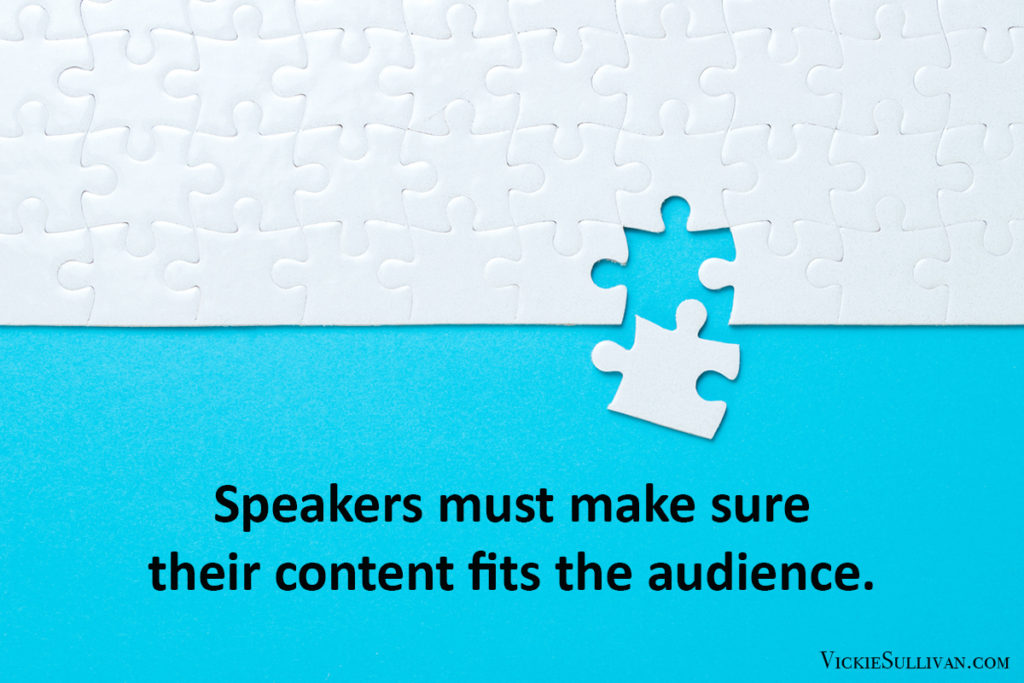Written by: Vickie Sullivan | July 11, 2019
How Great Speech Topics Go Bad

Being the clothes horse that I am, I looked forward to a panel discussion on fashion during an international business women’s conference in Spain. The speakers were prominent CEOs who have innovative business models. The anticipation from the audience was palpable.
And … the consensus among the attendees (including me) was that this session was the most disappointing. Which begs a bigger question: Can speakers lose an audience who loves them from the beginning? Yep. It’s easier to do than you think.
A lot of speakers start off strong by making the topic relevant. But then they drop the ball by not paying attention to how their audience defines the topic.
One of several examples from the fashion discussion: One speaker referred to shopping as an Instagram-worthy event. When an attendee suggested that customer service was more important to her than social media, the speaker noted that their target demographic was 20 (and sometimes 30) years younger than the audience and therefore, doesn’t care about getting help during the buying experience. The gasps were audible. Half the room was gone in an instant.
Listen: Two Things That Make a Great Topic Fall Flat
This is what happens when a topic is relevant on the surface but doesn’t deliver in the details. It’s not enough to make the topic attractive to your group. Speakers must make sure their content fits the audience. Don’t make this mistake.
Now Read This:

Author : Michelle Davidson
Published: 2019-07-12 11:25:17
I understand now what you mean. Absolutely, she should have answered the question/answered the concern.
Author : Vickie Sullivan
Published: 2019-07-11 13:43:12
Oh yes, you are absolutely right. I’ve noticed the same thing when shopping with the younger ones. My point is about the audience, not the accuracy. One thing the panelist could’ve said is something like “well, the definition of customer service is changing with the upcoming generation of shoppers...” That would’ve been OK. It was the non-answer and the insuation that lost the audience. Every speaker has time constraints, which is a perfect reason to be strategic about your comments. Just because something is true doesn’t mean we include it.
Author : Michelle Davidson
Published: 2019-07-11 04:04:15
As the parent of a 22-year-old young woman, I agree with the speaker/panelist who said shopping is an Instagram-worthy event. When young women go shopping – and I’ve witnessed this – they take pictures of everything. And Instagram and Snapchat are their mediums of choice. They especially like the Story feature in Instagram – where their posts are up for only 24 hours. These young women are drawn to settings and locations that make Instagram-worthy images. When they shop, the do not want to talk to any clerk. If they could make purchases self-service, they would. The only thing about customer service they care about is if the item they want is in stock and in their size. Most actually prefer an online shopping experience. So, to get them into a brick-and-mortar store, the store has to have something compelling. And Instagram-worthy settings seem to work. For example, I went with my daughter to the Primark store in Boston the day before the Game of Thrones final season opener only because they had a replica of the Iron Throne – which we took pictures of one another sitting in it – and then I spent a couple hundred dollars on clothes. That is for retail, but I’ve also seen my daughter make service purchases, and those are all strictly self-serve and online. Again – she doesn’t want to have to talk with anyone, so forget about her picking up the phone to call anyone. Just make sure the service is as advertised and that the website works properly and is secure. Having an artificial intelligence-driven chatbot to answer questions if they need help also works with these buyers – for services and products. Like the panelist said, in my experience people in their 20s and 30s, do not want help during the buying experience. They believe they are capable of handling purchases on their own. What they do want is an experience they can share with their followers. So companies need to make it a good one.